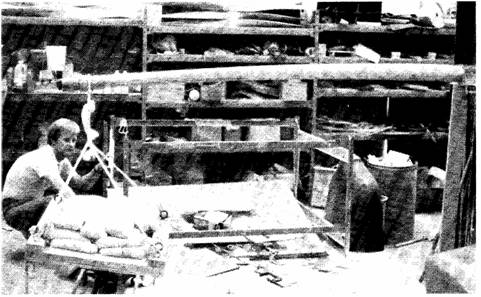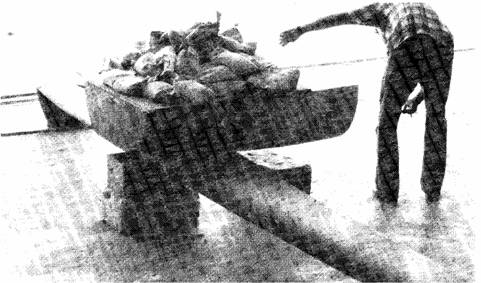| 4. | | Elevator Installation.
A few have had installation problems with elevators at B.L. 15. This can be solved one of several ways:
| A. | | When trimming excess foam from elevators to fit 72” tube, the INB’D core can trim at B.L. 17 and OUTB’D at B.L. 89, effectively increasing the gap at B.L. 15 slot core. | | B. | | Slot core can be trimmed slightly FW'D of trim line tapering outboard to allow deflection clearance. | | C. | | With burn down allowance and builder variation no change may be necessary to slot cores. |  |  |  |
| | 5. | | Drooped Wing Tips—
High Lift Devices.
Many of you want to be creative when building an airplane — sort of interject yourself into the project. Unfortunately, the parameters of the Quickie Design do not allow for much induced creativity; the design is a very low drag with little room for clean-up. Most add-on details only create more drag and weight. One area left to the builder’s discretion is the wing tip design, and we must take a look at that. Many of you have seen swoopy tips that turn up or down. Some are aesthetically pleasing and can even create more lift, particularly at high angles of attack and riding ground effect thru tip vortex modification. On a standard craft, that doesn’t impose a problem, but on a tandem wing, where landing qualities depend on an interaction between both lifting devices, harmony can be disrupted. Creating more lift on the AVF wing has a similar effect as adding more wing area. Our prototype has been modified several times to include wing extensions, reductions, etc. to find an optimum balance of lift for landing convenience within the flight envelope. If the AFT wing is allowed to fly an increased % longer than design parameters, a wheelbarrow effect might take place making the tail stay up longer than it should particularly at forward C. G. The most desirable landing configuration of this craft is a 3 point where positive tail wheel contact allows immediate ground directional control. So please, no add-on lift devices on the AFT wing — just aesthetically blended tips. | | 6. | | Rev Flo Fitting.
Conferring with Joe at Revmaster, they have a weatherhead o4E-664 90° fitting that they will modify for a pushon retro fit for the Rev-flo carb fuel line at $2.75. They also have a limited supply of braided hose with fittings that would require a bulkhead fitting to adapt at a reasonable price. | | 7. | | To route your rudder cables, first, run two long strings from rudder AFV1 picking least deflections possible, yet clearing all controls, Then drill holes thru bulkheads and flox nylaflo tubes in place for anti-chafing and minor dellections. Finally install rudder cables. |  |  |  |
| | 8. | | When installing copper foil antennas, I like to apply them over the glassed surface, then apply a 1 or 2 oz. glass cloth (usually available at model airplane shops) closeout over foil extending about 1” all-around. If a depression is needed for ferrite beads, level with micro and closeout with BID. | | 9. | | Large Tire Option for LS-1 Mod.
We are working on a drawing. | | 10. | | Aircraft Finish Mode Overview There are several techniques that can be employed to improve finish success ratio. First, in the building process, careful sanding of core transitions, fairings, etc., will demand less heavy fillers to create a smooth finish. Second, high quality finish products and careful sanding will insure greatest adhesion.
The approach I use is as follows:
| 1. | | Carefully sand entire airframe with 36-40 grit, finger sanding all depressions. (Sand entire surface dull.) | | 2. | | Map all heavy depressions, transitions, with felt tip VIA - line or circle, |  |  |  |
|  |  |  |
| | | | | 3. | | Fill all depressions with dry micro (overfill so one application will suffice), let cure, sand 36—40 grit VIA spline board. | | 4. | | Brush, or spray weave filler (I use Sterling or Eliminator by Morton Paint Co. rather than featherfill). A better approach might be to squeegee on first layer to reduce pin hole problems. | | 5. | | Spline surface smooth using methods in finish mode section. | | 6. | | Prime (pressure pot works nice) and fill pin holes, imperfections with high quality spot putty. Re-priming any surface cutting thru to bare glass. Wet sand for final finish. (We use DuPont 100-S.) | | 7. | | Paint! |  |  |  |
| | | | Sounds simple enough!
Finish is labor intensive. If you haven’t painted anything before, take it to a professional. You’ve spent a lot of time and labor, might as well have a super finish too. |  |  |  |
|





